
2024: The year of broken Navajo relations
January
We started the year reporting that Klee Benally had passed on. He was 48. He was the son of Jones and Berta Benally. He was from Dziłíjiin. The Naabik’íyáti Committee also recommended that the Navajo Nation Council override President Buu Nygren’s veto resolution that would approve virtual attendance at chapter meetings.
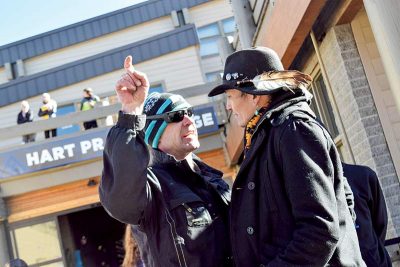
Navajo Times | Krista Allen
Klee Benally, a volunteer with Protect the Peaks organization, stares down the head of security for Arizona Snowbowl during a late December “mountain protector” demonstration at the ski resort, which uses 100 percent effluent to make artificial snow, in Flagstaff.
In the Jan. 4 edition, we reported the Division of Public Safety’s plan to implement rural addressing and E911.
In the Jan. 11 edition, we reported that Gallup’s Hozho Center found a new property, expanding its mission of empowering individuals through holistic recovery and cultural connection. We also reported that the Navajo Nation foiled criminal charges against two Diné it suggested were illegally growing marijuana for distribution. The prosecutor’s office alleged that Dineh Benally and Farley Blue-Eyes operated a massive high-grade marijuana operation in and around Shiprock in violation of Navajo law.
In the Jan. 18 edition, we reported that former Navajo Speaker Seth Damon resigned to take a job in the New Mexico government with New Mexico Gov. Michelle Lujan Grisham’s cabinet as her deputy secretary of Indian Affairs.
We also reported that 10 people were charged in the sober-living fraud case. Then Attorney General Ethel Branch and Navajo Nation entities said they were dedicated to cracking down on rehab home scams.
In the Jan. 25 edition, we reported that President Buu Nygren was “a little disappointed” after the Navajo Nation Council questioned him during the Winter Session. Nygren had reported his State of the Navajo Nation Address, celebrating accomplishments from different departments under his administration.
February
The Water Rights Unit is still protecting and securing water rights for Diné Bikéyah. The Navajo Nation Water Rights Commission and the Navajo Nation Department of Justice’s Water Rights Unit started the first nine public education meetings on water rights.

Special to the Times | Krista Allen
Lake Powell, better known as a disturbance flow, is released through the Glen Canyon Dam in Page, Ariz. Disturbance flows are periodically conducted and they are designed to simulate a spring-time runoff event, disturbing river bottom habitats.
In the Feb. 1 edition, we reported that many drivers are hitting potholes on roads and highways in the Fort Defiance Agency, damaging their vehicle’s tires. We also reported District 6 residents grappling with former Council Delegate Seth Damon’s sudden departure.
In the Feb. 8 edition, we reported that health care and tribal officials were looking for ways to address the health concerns of communities where the coronavirus took a heavy toll. We also reported that the new Shiprock hotel and restaurant has a name: “Shiprock Pinnacle Hotel and Shiprock Pinnacle Restaurant.”
Diné leaders also broke ground on Jan. 19 for a new Tohatchi High School building.
In the Jan. 15 edition, we reported that Jeff Irving of Pinedale, New Mexico, pleaded guilty to charges stemming from a drunk-driving incident during Gallup’s 100th Inter-Tribal Indian Ceremonial parade in August 2022.
Former Speaker Seth Damon’s legislative district assistant, Lester Charles Yazzie, was sworn in as an interim Council delegate. We also reported that dogs and cats with deadly diseases are ending up in Navajo Nation animal shelters. And more veterinary professionals are needed in the Navajo Nation.
In the Feb. 22 edition, we reported that Adopt-A-Native Elder Navajo Rug Show had been supporting Diné weavers for 40 years. Seven spellers competed in the Eastern Agency Bee.
We also reported that Scottsdale gallery owner Gilbert Ortega would not be facing charges after a racist tirade against Native performers in February 2023.
March

Navajo Times | Krista Allen
A pair of Diné workers make gauge steel for a ZenniHome structure inside the company’s factory at the decommissioned Navajo Generating site in LeChee, Ariz. Dec. 9.
The Navajo Nation neared completion of a settlement of water rights claims in Arizona, ending decades of negotiations and giving hope to thousands of people who have gone without running water. We also reported that the Navajo Nation Gaming Enterprise was committed to raising awareness about gambling problems within Diné Bikéyah.
In the March 14 edition, we reported that President Buu Nygren signed an ARPA grant allowing Indigenous Design Studio + Architecture to expand production at ZenniHome in LeChee, Arizona.

Navajo Times | Jan-Mikael Patterson
Navajo Times/Office of Diné Youth Final Regional Spelling Bee Champion Shynelle Joe is a sixth-grade student at Tsaile Public School. She was declared the spelling bee champion after correctly spelling the anticipated championship word, “rankles.”
In the March 21 edition, we reported that Class 59 – the “magnificent seven” – graduated from the Navajo Police Training Academy.
We also reported that Lewnell Harrison, the interim Navajo Nation Ethics and Rules director, said it was a conflict of interest for him to receive and personally benefit from a $102,001.68 contract with the controller’s office.
In the March 28 edition, Lók’a’ch’égai girl Shynelle Joe, a sixth grader, won the Navajo Times/Office of Diné Youth final regional spelling bee. Her championship word was “rankles.”
We also reported that the Navajo Nation Judicial Branch celebrated its 65th anniversary with “Justice Day” events across the Navajo Nation.
April
Two Diné families sued Arizona and several entities, claiming they’re liable for their loved ones’ deaths because of a lack of oversight on the sober living crisis, which led to one of the largest health care scandals in Arizona history.
In the April 2 edition, we reported that the Missing and Murdered Indigenous Women and Relatives crisis, a silent epidemic, is still a top issue.
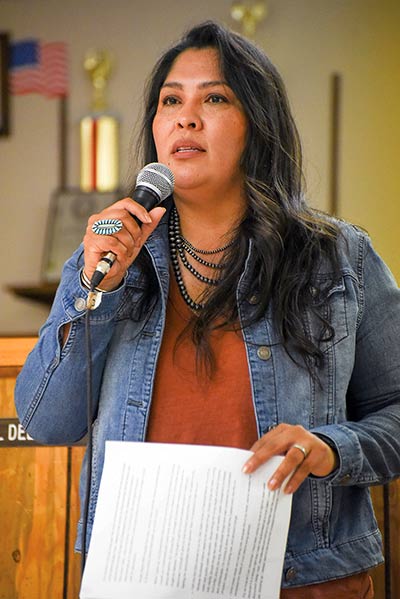
Navajo Times | Krista Allen
Davina Smith, from Tsébii’ndzisgaii, speaks to her constituents during a campaign rally at Aneth Chapter House in T’áá Bíích’į́į́dii. Smith, who resides in Blanding, is running for the Utah House’s 69th district seat. The district comprises 90% public lands, including Shash Jaa’ and Grand Staircase-Escalante in southeastern Utah.
In the April 11 edition, Davina Smith launched a second bid for Utah’s House District 69, and Tuba City’s Angie Williams announced she’s running for Coconino County District 5 Supervisor Lena Fowler’s seat. Aneva J. Yazzie also retired from the Navajo Housing Authority. Yazzie served as the entity’s deputy chief executive officer.
We also reported that after nearly 55 years, the land leased by the U.S. Bureau of Reclamation and five utilities to build the Navajo Generating Station was returned to the Navajo Nation. First lady Jasmine Blackwater-Nygren said the inaugural “Welcome Baby Celebration” would be “fun and exciting.”
Light Up Navajo V was underway with the American Public Power Association. Forty-two electric utility companies from 16 states participated in the LUN V initiative from April 7 to July 20.
Chief Justice JoAnn Jayne named Bennie Francisco Jr. the administrator director of courts with the Administrative Office of the Courts. His appointment was effective April 1, 2024. And Kin Dah Łichí’í School ‘Ólta’ student Chase Tuni from Apache County was among the 15 winners of the AZ529 statewide Art Contest.
May
Quarrels, heated arguments, and harassment were rising at chapter meetings. The Law and Order Committee held a special meeting regarding these shared mishaps. The LOC members heard reports from the Navajo Police Department, the prosecutor’s office, and the ethics and rules office on how to respond to the incidents.
In the May 2 edition, we reported that Kassie John, a fifth-generation rug weaver, was crowned the 2024-25 Miss Indian World. The Federal Energy Regulatory Commission also denied Pumped Hydro Storage LLC preliminary permits to dam Big Canyon. Navajo Tribal Utility Authority Wireless general manager Velena Tsosie, who worked for the entity for 18 and a half years, accused NTUA general manager Walter Haase of sexually assaulting her in 2022.
We also reported that President Buu Nygren signed legislation that adds the Navajo Nation Council’s imprimatur to ban the transportation of uranium ore across Navajo lands.

Special to the Times | Donovan Quintero
Geri Hongeva-Camarillo records a video of the 21st Annual Lori Piestewa Navajo Hopi Honor Ride stop outside the Page Council Chamber in Dá’deestł’in Hótsaa last Friday.
In the May 9 edition, we reported that a few San Juan River Farm board representatives expressed concerns about farm plots and hemp farm huts left behind by Dineh Benally. Diné officials also requested the Biden Administration to halt the movement of uranium ore across Diné Bikéyah.
The Navajo Nation closed its purchase of the Goulding’s Resort and Tours on April 26. Since that date, only a few changes have been made to the Monument Valley lodge operations.
We also reported that the family of Davidson Darren Tso, a Diné who was found earlier this year, was seeking accountability, claiming tribal authorities mishandled the case. The family organized a prayer march in Chinle on May 10.
In the May 16 edition, we reported the Polo Ralph Lauren x Naiomi Glasses “Color in Motion,” which encourages people to “can do anything.” President Buu Nygren also urged passage of U.S. Sen. Josh Hawley’s RECA amendments to expand benefits for former uranium miners.
In the May 23 edition, we reported that honor riders remembered the late Lori Piestewa, Native service members, and Gold Star families.
We also reported that a Farmington High School senior, Genesis White Bull, set to graduate on May 13, had her cape taken from her because it violated school graduation protocol.
In the May 30 edition, former Nygren staffer Marvin Murphy filed a sexual harassment complaint against Vice President Richelle Montoya. We also reported that after a decades-long fight, the Navajo Nation’s Arizona water rights were a step closer to acquiring about 60 billion gallons of water annually.
When Montoya, on April 16, revealed on Facebook that she was sexually harassed during a meeting, she didn’t name the perpetrator. But Nygren denied sexual harassment allegations.
We also reported that John Kinsel Sr., the late Navajo Code Talker’s home, was being renovated.
Longtime Chief Legislative Counsel Dana Bobroff resigned on May 28.
June
President Buu Nygren believed the stories about his administration published in the Navajo Times were meant to discredit and attack him. “The Navajo Times is printing false stories in the paper,” he said in his weekly radio address on May 30. “I’m not happy about that.”
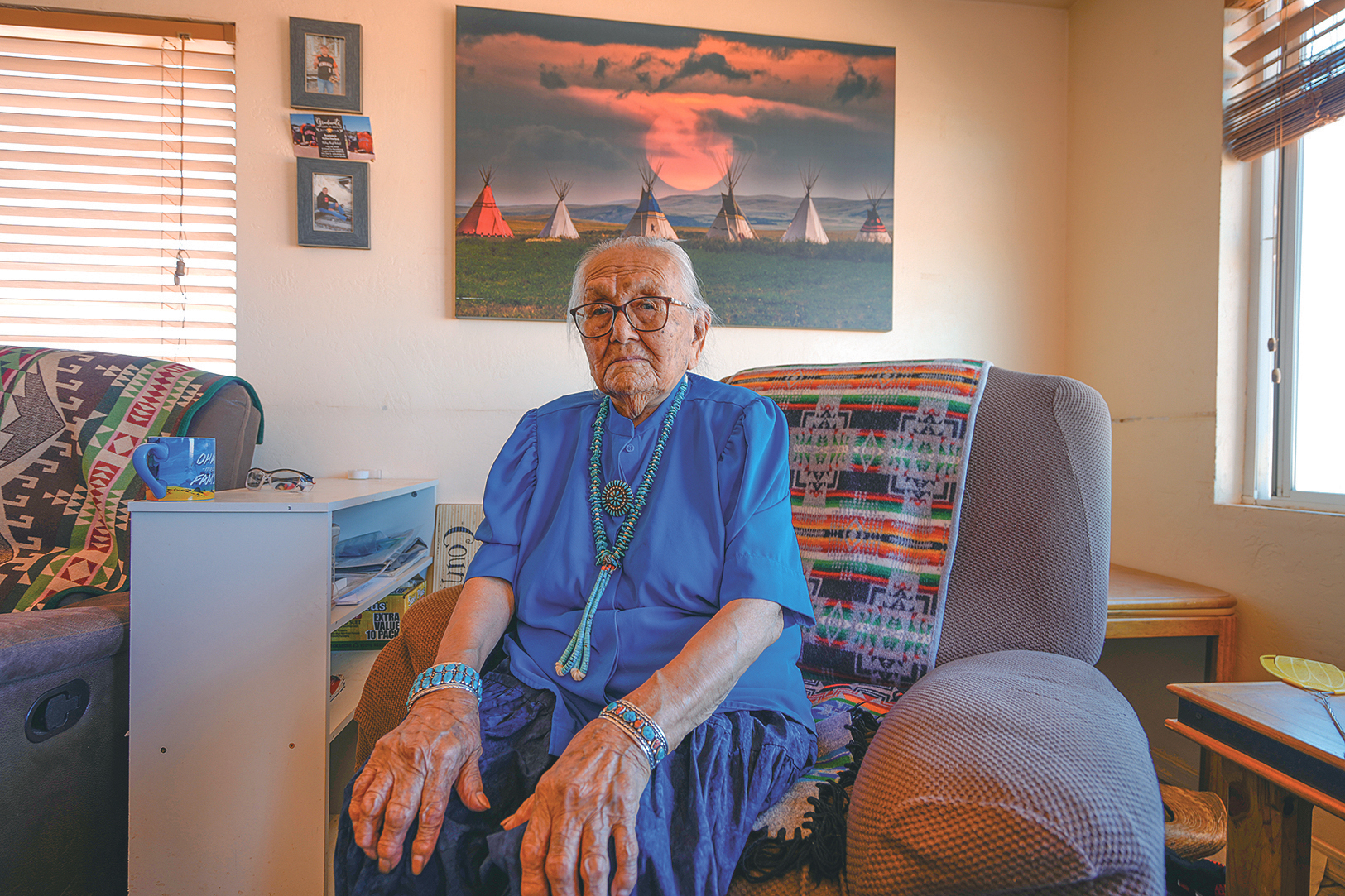
Special to the Times | Donovan Quintero
Pearl Begay, 99, grew up hauling water and herding sheep in LeChee, Ariz. Currently, she said she gets her water from Kaibeto, Ariz., 31 miles to the southeast.
In the June 6 issue, we reported that then Attorney General Ethel Branch selected Eric N. Dahlstrom to review improper employment practices in the president’s office. Vice President Richelle Montoya said she stood for those who have experienced sexual harassment, assault, bullying, and other misconduct.
We also reported that Kari Lake, a candidate for the U.S. Senate campaign, visited Navajoland in St. Michaels, Arizona, on June 1. Lake swung through the Navajo Nation and visited with Faith Leaders of the Navajo Nation.
In the June 13 edition, we reported that the Colorado River was testing 99-year-old Pearl Begay’s resilience. She told the Navajo Times that Bilagáana believe the water belongs to them. At Gallup Indian Medical Center, medical professionals said the hospital is not safe.
We also reported that former President Jonathan Nez continued to push for Congress.
The Navajo Times announced that its Jack Ahasteen Comics would no longer be printed in the paper. The cartoonist separated from the Navajo Times Publishing Co. Inc. Navajo Police Chief Daryl Noon resigned, but it was “forced.”
In the June 20 edition, we reported that Michelle Paulene Abeyta won the primary election for NM House District 69. Apache County Attorney Michael Whiting and his two assistants were being investigated for public corruption.
July
Azee’ Bee Nahaghá continued to “take care” of the medicine. Coconino County District 5 Supervisor Lena Fowler also announced she’s running for reelection.
In the July 3 edition, the topic of feral horses overgrazing lands that Navajo ranchers use to support their livestock was discussed during a report from the Navajo Nation Department of Agriculture to the Resources and Development Committee.
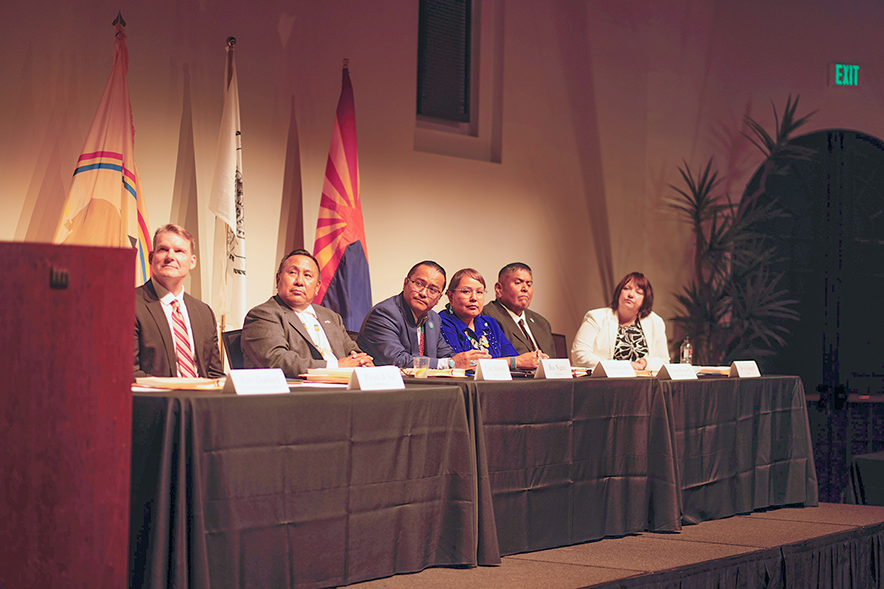
Special to the Times | Donovan Quintero
Hopi Vice Chairman Craig Andrews, President Buu Nygren, Speaker Crystalyne Curley, and San Juan Southern Paiute President Robbin Preston Jr. pose for a photo during a July 17 signing ceremony at the Heard Museum’s Steele Auditorium in Phoenix for a historic water settlement.
In the July 11 edition, Navajo Nation officials who’ve been at the helm to finalize a deal that would secure the tribe’s water rights forever said they won’t stop fighting until the settlement is ratified by the federal government. We also reported the Law and Order Committee questioned the Navajo Division of Public Safety and its priorities. The LOC members heard various concerns during their regular meeting. Debbie Nez-Manuel was terminated as the Division of Human Resources executive director on June 27, 2024.
In the July 18 edition, the Navajo Nation Council convened its Summer Session amid the president’s absence. We also reported that Navajo leadership, along with Hopi and San Juan Southern Paiute leaders, signed the Northeastern Arizona Indian Water Rights Settlement Agreement that, at least, signified the seriousness of the three tribes’ intent to settle their water rights.
The Shiprock Associated Schools Inc. administration, board members, and Navajo leadership broke ground for a new residence hall.
We also reported over 9 million gallons of water pumped out of the Pinyon Plain mineshaft in December 2023, flooding has caused spikes in heavy metals in the water, according to Energy Fuels Resources’ Pinyon Plain Mine 2023 aquifer protection permit report.
In the July 25 edition, leadership from the Navajo Nation, the Hopi, and the San Juan Southern Paiute tribes meet before the U.S. House Natural Resources Subcommittee on Water, Wildlife and Fisheries inside the Morris K. Udall Room in the Longworth House Office Building in Washington, D.C. on July 23.
In the July 25 edition, Arizona Sen. Mark Kelly addressed critical questions surrounding the Indian Water Rights Settlement, shedding light on its significance for tribal communities and the broader implications for water rights in the region.
August
The coronavirus was still on the rise in August, but the good news was no measles outbreak. Former President Jonathan Nez secured the Democratic nomination for Arizona’s second congressional district. Nez’s victory in the primary made history.
In the Aug. 1 edition, we reported that the transport of uranium ore from Pinyon Plain Mine – to the White Mesa Mill in Blanding, Utah – started. Light Up Navajo V concluded with 170 homes connected to the electric grid.
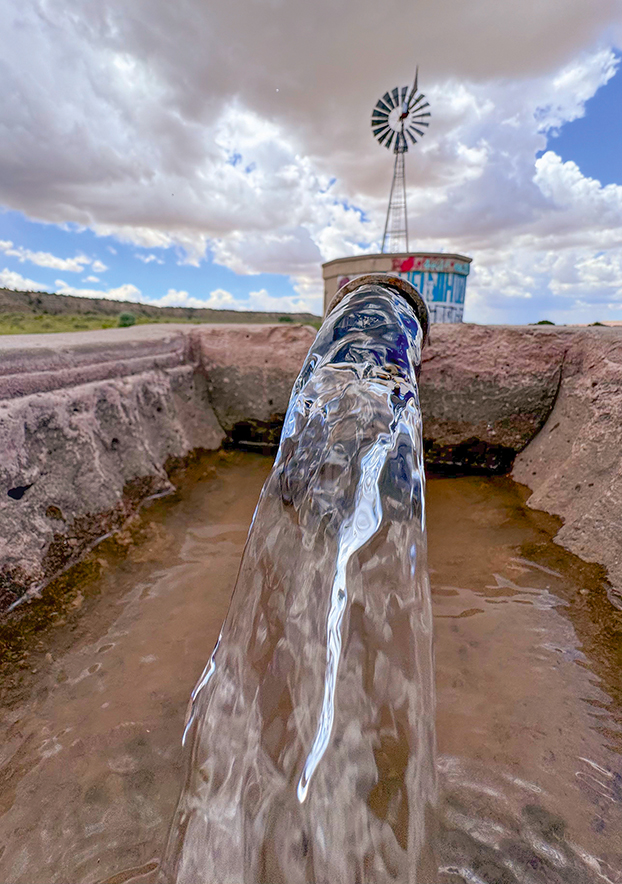
Special to the Times | Donovan Quintero
Crystal clear water gushes into a trough that livestock and wildlife use in Greasewood Springs, Ariz., on June 28.
We also reported that Terilynn Charley was crowned the 2024-25 Miss Eastern Navajo. Dixie’s Lower Antelope Canyon Tours celebrated 10 years of hard work and giving back. The family business celebrated on May 14.
Efforts to recall President Buu Nygren also was underway. The effort is led by Debbie Nez-Manuel, the former Division of Human Resources executive director. We also reported Utah Diné Bikéyah celebrating 10 years of the Bears Ears Summer Gathering.
In the Aug. 15 edition, we reported that Acting Labor Secretary Julie Su visited a Tuba City job fair on Aug. 7. We also reported that the Gallup Indian Medical Center was in line for a $1.2 billion facility replacement because of the problems that could potentially cause it to create greater unsafe conditions for patients.
The Navajo Nation also celebrated Navajo Code Talkers Day at the Navajo Nation Fairgrounds in Window Rock. Environmental and cultural advocates also expressed outrage following the approval and signing of the Snowbowl Memorandum of Agreement by the Arizona State Historic Preservation Office, the Advisory Council for Historic Preservation, and the U.S. Forest Service.
In the Aug. 29 edition, we reported that the San Juan Southern Paiute Tribe was awaiting Congress approval for a historic water rights settlement. We also reported major disqualifications hitting the Navajo Nation elections ahead of the November polls.
Former President Jonathan Nez also continued to charge for Republican Eli Crane’s seat.
September
In September, six Diné women – Dayhenoa Ch’ikeeh Nizhoonii Yazzie, Kiana Omi Toadlena, Ranisha Chrislyn Begay, Niaomi Ranae Benally, Quandinna Cheyanne Begay, and Taneesha Francis – competed for the Miss Navajo Nation title.
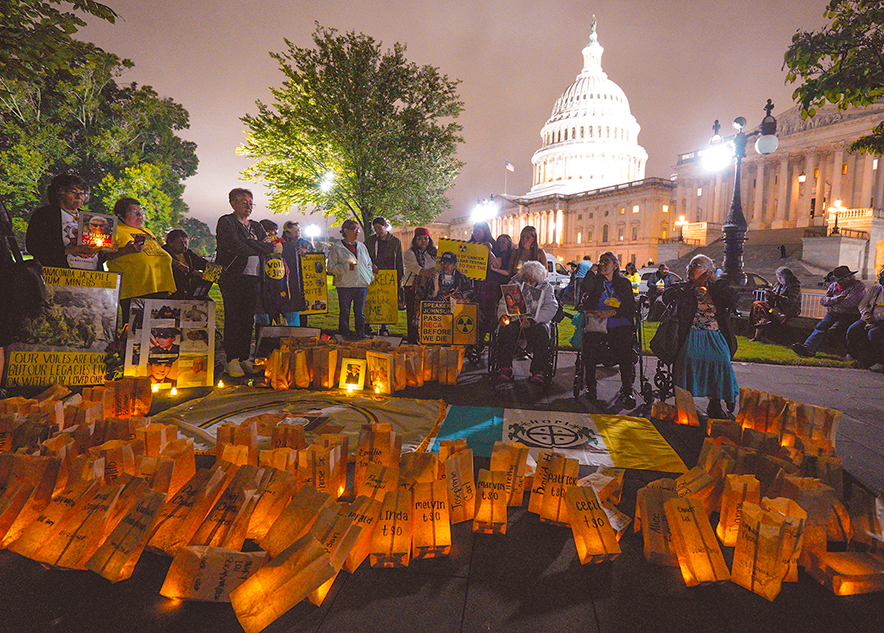
Special to the Times | Donovan Quintero
A group comprising tribal members from the Navajo Nation, Acoma Pueblo Nation, Laguna Pueblo Nation, and Hopi Tribe hold a candlelight vigil to remember their loved ones who lost their lives to uranium-related cancers. The group traveled by bus for more than 37 hours to advocate for the passage of a Radiation Exposure Compensation Act expansion bill on Sept. 25 in Washington, D.C.
Ranisha Chrislyn Begay of Tsé Nitsaa Deez’áhí was selected for the 2024-25 Naabeehó Bich’eekį on Sept. 7, during the 76th Annual Navajo Nation Fair in Tségháhoodzání. She is Nát’oh Dine’é Táchii’nii and born for Ta’neeszahnii. Her maternal grandfather is Kinyaa’áanii, and her maternal grandfather is Yé’ii Dine’é Táchii’nii.
The 76th fair honored heritage and celebrated harvest, livelihood, and kinship.
In the Sept. 5 edition, we reported that Chinle Chapter President Rosanna Jumbo-Fitch was disqualified from the general election. But she remained undeterred in her commitment to serving the Chinle community. She was one of 192 candidates who were disqualified for failing to meet the new reporting requirements.
In the Sept. 12 edition, we reported that the Coppermine Chapter in Western Navajo earned the 2024 John Keller Award for its planning initiative through geodesign.
In the Sept. 19 edition, we reported that the 25th Navajo Nation Council approved emergency legislation to avert a government shutdown. The legislation was designed to maintain government operations for six months.
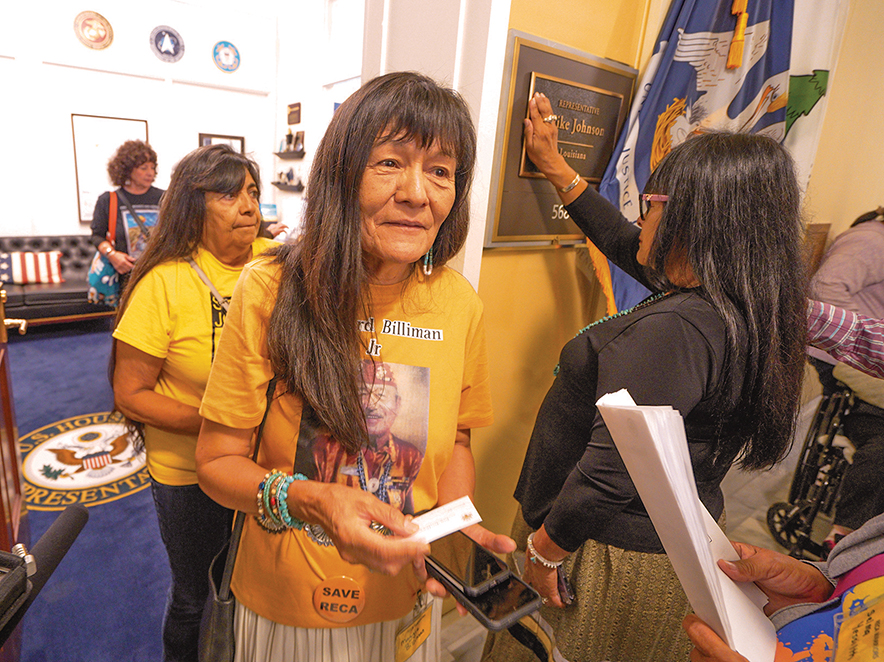
Special to the Times | Donovan Quintero
Maggie Billiman reacts after the group, which traveled more than 37 hours on a bus from Albuquerque, drops off medical invoices at the office of House Republican Speaker Mike Johnson on Sept. 25 in Washington, D.C. Kathleen Tsosie, right in a black T-shirt, touches Johnson’s plaque while she prays after submitting her medical invoice to his office.
In the Sept. 26 edition, we reported that the Navajo Nation disqualified candidates ahead of the chapter general election on Nov. 5. The Navajo Board of Election Supervisors needed to decide to remove all candidates from the 2024 chapter general election ballots.
Diné leaders gathered on Sept. 25 to provide compelling testimony before a Senate committee in support of a critical water rights settlement benefiting the Diné Bikéyah, the Hopi Tribe, and the San Juan Southern Paiute Tribe.
Interior Secretary Deb Haaland also rallied the Navajo Nation on Sept. 22-23 for the Harris-Walz ticket. Allie Redhorse Young’s “Ride to the Polls” initiative – a trail ride and voter tune-up movement – moved through the Navajo Nation.
We also reported that a group rode a bus to the nation’s capital to advocate for the passage of the Radiation Exposure Compensation Act. The group, comprising Navajo Nation, Laguna Pueblo, Acoma Pueblo, and Hopi elderly tribal members, had five days to convince House Speaker Mike Johnson to allow a vote on legislation that would aid victims of U.S. nuclear tests, uranium mining, and nuclear waste storage.
October
An endeavor that began on the morning of Sunday, Sept. 22, a group of Navajos, Acoma Pueblos, Laguna Pueblos, and Hopi people left on a bus from Albuquerque for a weeklong trip to Washington, D.C., to try and meet with the man, House Speaker Mike Johnson, to ask him why he chose not to push Missouri Congressman Josh Hawley’s Radiation Exposure Compensation Act otherwise known as RECA. The group met at the U.S. capital, where they held a vigil to remember their loved ones who lost their lives to mining-related and atmospheric nuclear testing. Their story was shared in the Oct. 3 issue. Ultimately, RECA was not passed under the 118th Congress.
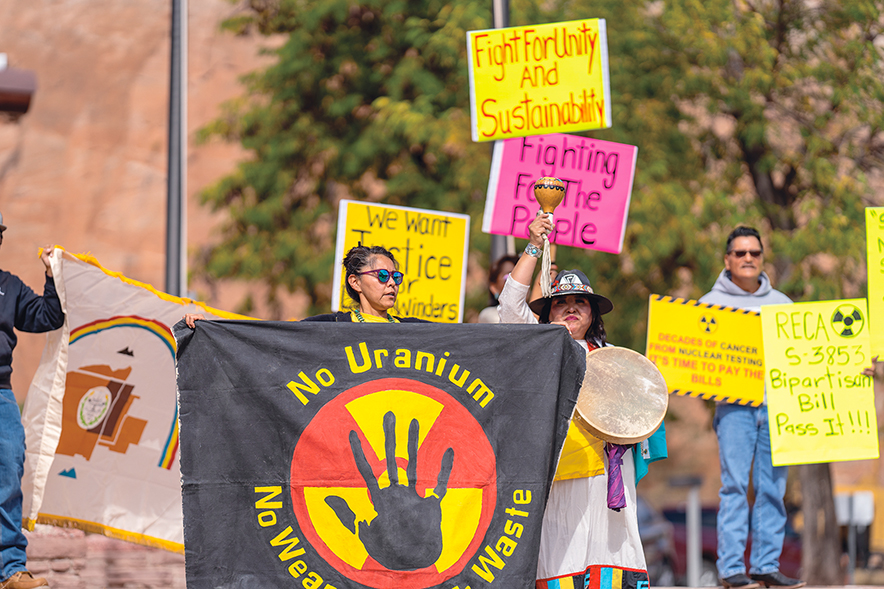
Special to the Times | Donovan Quintero
An activist against uranium mining holds a banner on Monday in Window Rock.
Democratic challenger and Shonto, Arizona, native Jonathan Nez showed Arizona District 2, the largest district in Arizona, that Republican incumbent Eli Crane was beatable despite the district being made up of Republican voters. Nez, according to election polls leading up to Nov. 5., had him gaining on Crane. On election day, voters went to the voting booths and cast their votes. A week or so later, the final official vote count was released that showed Crane defeating Nez, 221,413 to 184,963. Nez’s campaign story was shared in the Oct. 10 issue. The Navajo Times reached out to Crane’s campaign numerous times for a request for an interview, but they never responded, failed to follow through during the Navajo Nation Fair, or denied the request and only offered a screenshot of a statement they posted on their social media pages.
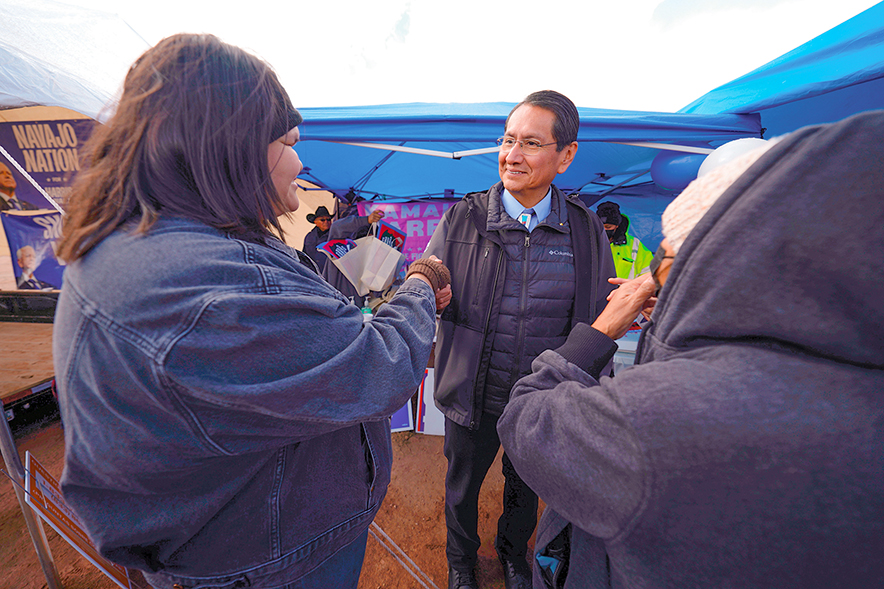
Special to the Times | Donovan Quintero
Former Navajo Nation President Jonathan Nez greets his constituents after speaking at a campaign rally on Sunday in Dilkon, Ariz.
In the Oct. 17 edition, we reported the power of a vote can do if candidates like the late Peterson Zah were elected to office. Rosalind Zah, the wife of the late Navajo tribal chairman and first Navajo Nation President Zah, shared his story while attending a “Walk to the Polls” rally at the Navajo Nation Museum. Mrs. Zah said her late husband, when faced with a problem, turned to his late mother for counsel. “Pete’s legacy is alive in the hearts of those he touched. It’s up to us to carry it forward,” Mrs. Zah said.
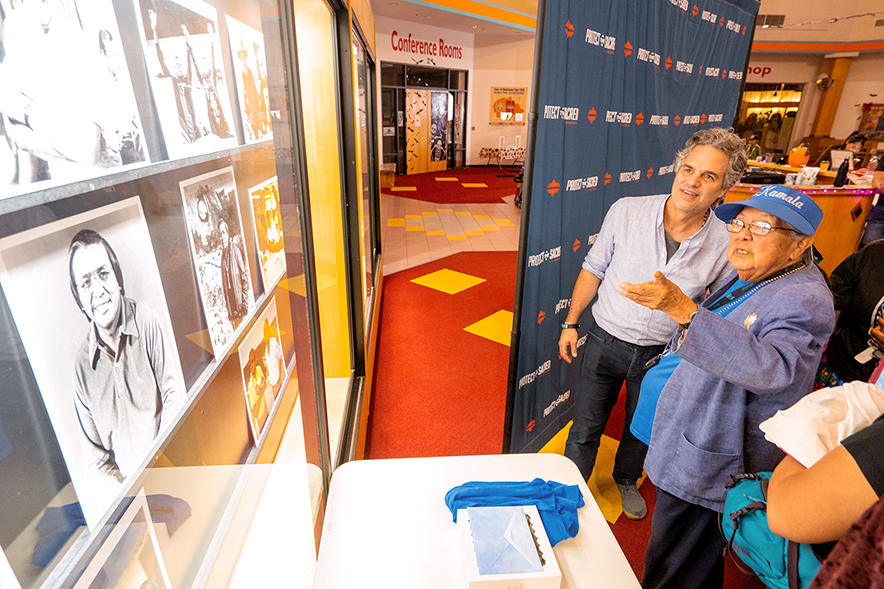
Special to the Times | Donovan Quintero
Rosalind Zah shows Mark Ruffalo photos of her late husband, former Chairman and Navajo Nation President Peterson Zah, on Saturday evening at the Navajo Nation Museum in Window Rock. Ruffalo is an actor, director, and advocate for climate justice and renewable energy.
The Oct. 12 edition of the Navajo Times had the unfortunate duty to tell the story of the passing of a great warrior: Navajo Code Talker John Kinsel Sr. Mr. Kinsel died peacefully at his home, said his son Ronald Kinsel, at the age of 107. Kinsel was laid to rest in Lukachukai, Arizona, where he built a home for his family after WWII.
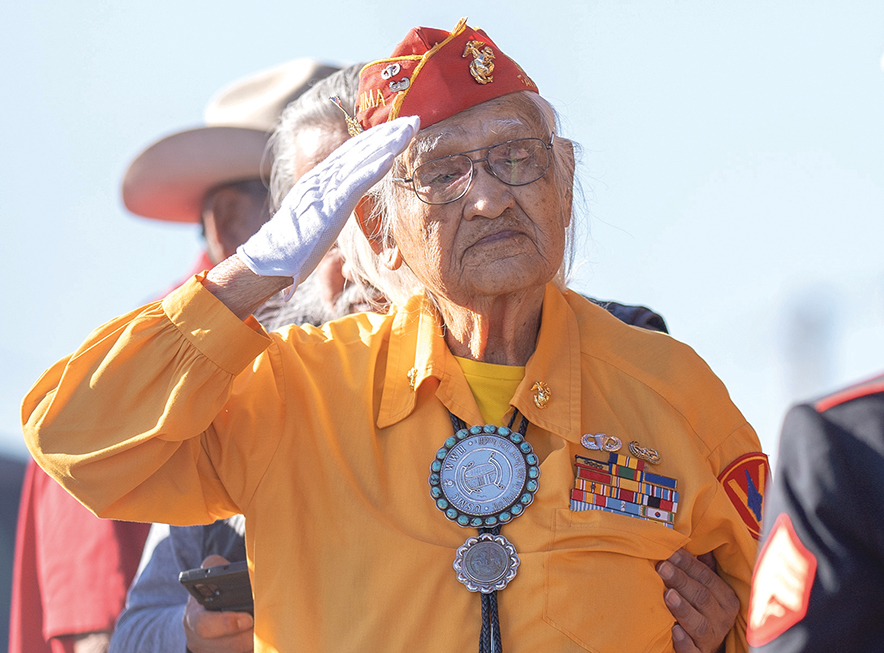
Special to the Times | Donovan Quintero
Navajo Code Talker Thomas H. Begay gives one final salute to his longtime friend and fellow Navajo Code Talker John Kinsel Sr., on Wednesday in Chinle. Kinsel passed at his home in Lukachukai, Ariz., on Saturday morning.
Just days before the Nov. 5 general election, Democratic vice presidential candidate and Minnesota Gov. Tim Walz was escorted to Window Rock under heavy police security provided by the New Mexico State Police and Navajo Nation Police to encourage Navajo voters to vote “blue.” Walz’s convoy was met at the Arizona-New Mexico state line by Navajo citizens who showed him their allegiance was for Donald Trump and JD Vance. The Democrats did not get their way when the country decidedly re-instilled the former president into office.
November
Two days after Navajo voters made their voices heard in the form of their votes, the Navajo Times, in its Nov. 7 issue, published a story on how freshly elected chapter-level leaders would encourage Navajo citizens to continue staying engaged. St. Michaels Chapter secretary-elect Chris Bahe and St. Michaels Chapter vice president-elect Craig Tsosie both said making virtual chapter meetings for its chapter members was a possible solution. Both newly elected leaders also have the daunting task of ensuring allocated ARPA funds are spent before Dec. 31, 2026.
Tribal leaders, President Buu Nygren and Speaker Crystalyne Curley continued advocating for the passage of three key water rights – the Northeastern Arizona Indian Water Rights Settlement, the Navajo Nation Rio San José Stream Water Rights Settlement, and the Navajo-Gallup Water Supply Project. Their plights were published in the Nov. 14 edition of the Navajo Times. Both leaders, despite tensions growing between the two due to a failure to pass a tribal comprehensive budget, worked diligently to convince federal officials to OK the bill so that President Biden could sign it before the Trump Administration took over. Ultimately, just the Navajo-Gallup Water Supply Project survived.
In the Nov. 21 edition, Diné Development Corporation announced the opening of a Navajo Code Talker building nearly 1,600 miles away. We reported that since DDC established itself in the city of Dayton, a Navajo Code Talkers building was opened to serve as the headquarters for DDC, which is owned by the Navajo Nation. The move highlighted the growth and expansion of the corporation’s operations beyond the Navajo Nation, emphasizing its strong ties to federal contracts and its role as an innovation center. Dayton was chosen due to its strategic location and reputation as a hub for innovation and entrepreneurship. The city’s historical ties to the U.S. military, aviation, and its strong defense sector made it an ideal site for the DDC to expand its footprint and enhance its mission of supporting both the Navajo Nation and the broader U.S. economy. Additionally, Dayton offers access to a skilled workforce and a growing business environment, which aligns with the corporation’s vision for sustained development and community investment.
In the Nov. 27 edition, we highlighted a need to enhance community wellness and address chronic health issues. The Talking Circle centered on themes of Thanksgiving and gratitude, providing a safe space for participants to reflect on the holiday’s meaning and process personal challenges, grief, and generational trauma. The next talking circle will be on Jan. 22 at the Navajo Nation Museum hogan.
December
This month, we highlighted the Navajo Nation working on using funds from the American Rescue Plan Act, or ARPA, because it faces significant challenges that could jeopardize its timely deployment. While progress has been made in some regions, administrative delays and logistical inefficiencies have stalled many projects, leaving substantial funds unspent or awaiting legislative approval. Despite setbacks, ARPA funds have supported vital infrastructure improvements, but ongoing inefficiencies threaten their full implementation.
In the Dec. 12 edition, we reported an alleged incident that occurred at the Tuba City Boarding School. Community members, parents, and Navajo Nation leaders focused on systemic reforms to better protect students. The Navajo Nation Council has taken a leading role in responding to the community’s concerns.
“K’é fails,” titling a Dec. 19 story, depicts the continued demise between President Buu Nygren and Vice President Richelle Montoya. Having not yet reached their second year, the two elected officials have publicly accused one another of either alleged sexual harassment or incompetency to faithfully be an elected leader for the Navajo people.








 Highway 264,
Highway 264, I-40, WB @ Winslow
I-40, WB @ Winslow